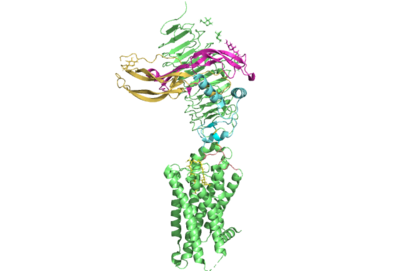Sandbox Reserved 1781
From Proteopedia
(Difference between revisions)
| Line 7: | Line 7: | ||
== Introduction == | == Introduction == | ||
[[Image:All_TSHR.png|400 px|right|thumb|Figure 1. TSHR with TSH bound]] | [[Image:All_TSHR.png|400 px|right|thumb|Figure 1. TSHR with TSH bound]] | ||
| - | Thyroid hormones exercise essential functions related to thymocyte activity as well as metabolic processes and oxygen consumption. Misregulation of thyroid hormones is the cause of many disorders related to hypo- or hyperthyroidism. Thus, understanding the signaling of synthesis and release of these hormones is essential to the development therapeutic drugs to combat disorders <ref name="Yen">PMID:11427693</ref>. The initiation of the synthesis and release of these hormones is caused by the glycoprotein, thyroid stimulating hormone, commonly referred to as TSH or thyrotropin. The thyrotropin receptor (TSHR) is a G-protein coupled receptor that binds TSH and transduces signal through the cellular membrane in order to initiate synthesis and release of thyroid hormones (Figure 1)<ref name="Kohn">PMID:7709602</ref>. | + | [https://en.wikipedia.org/wiki/Thyroid_hormones Thyroid hormones] exercise essential functions related to thymocyte activity as well as metabolic processes and oxygen consumption. Misregulation of thyroid hormones is the cause of many disorders related to hypo- or hyperthyroidism. Thus, understanding the signaling of synthesis and release of these hormones is essential to the development therapeutic drugs to combat disorders <ref name="Yen">PMID:11427693</ref>. The initiation of the synthesis and release of these hormones is caused by the glycoprotein, thyroid stimulating hormone, commonly referred to as TSH or thyrotropin. The thyrotropin receptor (TSHR) is a G-protein coupled receptor that binds TSH and transduces signal through the cellular membrane in order to initiate synthesis and release of thyroid hormones (Figure 1)<ref name="Kohn">PMID:7709602</ref>. |
== Structure == | == Structure == | ||
Revision as of 20:32, 20 March 2023
| This Sandbox is Reserved from February 27 through August 31, 2023 for use in the course CH462 Biochemistry II taught by R. Jeremy Johnson at the Butler University, Indianapolis, USA. This reservation includes Sandbox Reserved 1765 through Sandbox Reserved 1795. |
To get started:
More help: Help:Editing |
Your Heading Here (maybe something like 'Structure')
| |||||||||||
References
- ↑ Hanson, R. M., Prilusky, J., Renjian, Z., Nakane, T. and Sussman, J. L. (2013), JSmol and the Next-Generation Web-Based Representation of 3D Molecular Structure as Applied to Proteopedia. Isr. J. Chem., 53:207-216. doi:http://dx.doi.org/10.1002/ijch.201300024
- ↑ Herraez A. Biomolecules in the computer: Jmol to the rescue. Biochem Mol Biol Educ. 2006 Jul;34(4):255-61. doi: 10.1002/bmb.2006.494034042644. PMID:21638687 doi:10.1002/bmb.2006.494034042644
- ↑ Yen PM. Physiological and molecular basis of thyroid hormone action. Physiol Rev. 2001 Jul;81(3):1097-142. PMID:11427693 doi:10.1152/physrev.2001.81.3.1097
- ↑ Kohn LD, Shimura H, Shimura Y, Hidaka A, Giuliani C, Napolitano G, Ohmori M, Laglia G, Saji M. The thyrotropin receptor. Vitam Horm. 1995;50:287-384. PMID:7709602 doi:10.1016/s0083-6729(08)60658-5

